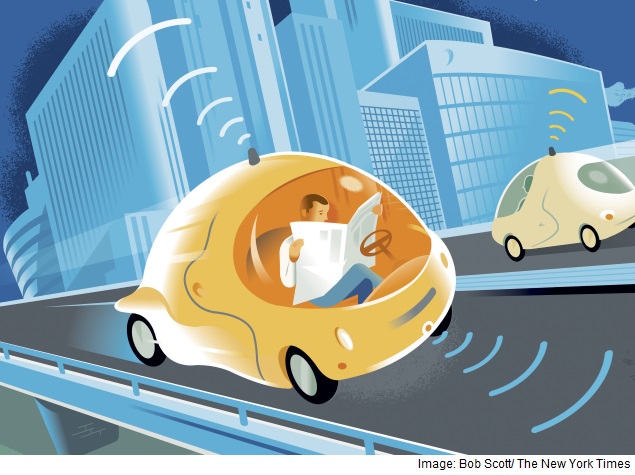- Home
- Others
- Others Features
- Tipping Point in Transit
Tipping Point in Transit

Instead, I write about the future, and embedded in the S550 are a host of technologies that roughly approximate the future of automobile transportation - already available, for a high price, on the road today.
For decades, pundits and theorists have been expecting a future in which cars drive themselves, and companies like Google have been testing advanced versions of these systems for several years.
But the S550 - some of whose self-driving features can be found in other luxury automobiles, including Cadillacs, Volvos and soon the Tesla Model S - shows that in many ways, the future of transportation is already here, and it is evolving at a pace that would surprise even the most optimistic enthusiasts.
And today's semiautonomous road car isn't the only sign that transportation is changing quickly. Because of on-demand services like Uber, the very idea of owning a car is being undermined.
Observers say that advances in transportation may be especially apparent in cities, where technology is creating an emerging multitude of options, from app-powered car sharing and car pooling to new modes of driving and parking to novel forms of short-distance travel and private jitney buses with seats allocated by phone.
Communication systems and sensors installed in streets and cars are creating the possibility of intelligent roads, while newer energy systems like solar power are altering the environmental costs of getting around. Technology is also creating new transportation options for short distances, like energy-efficient electric-powered bikes and scooters, or motorcycles that can't tip over.
"Cars and transportation will change more in the next 20 years than they've changed in the last 75 years," said M. Bart Herring, the head of product management at Mercedes-Benz USA. "What we were doing 10 years ago wasn't that much different from what we were doing 50 years ago. The cars got more comfortable, but for the most part we were putting gas in the cars and going where we wanted to go. What's going to happen in the next 20 years is the equivalent of the moon landing."
Herring is one of many in the industry who say that we are on the verge of a tipping point in transportation. Soon, getting around may be cheaper and more convenient than it is today, and possibly safer and more environmentally friendly, too.
But the transportation system of the near future may also be more legally complex and, given the increasing use of private systems to get around, more socially unequal. And, as in much of the rest of the tech industry, the moves toward tomorrow's transportation system may be occurring more rapidly than regulators and social norms can adjust to them.
"All the things that we think will happen tomorrow, like fully autonomous cars, may take a very long time," said Bryant Walker Smith, an assistant professor at the University of South Carolina School of Law who studies emerging transportation systems. "But it's the things we don't even expect that will happen really fast.
A step toward that future is something that Mercedes calls, clunkily, Distronic Plus with Steering Assist, a kind of advanced cruise control that lets a vehicle basically drive itself on freeways. Using radar and cameras, the S550 can center itself within a lane, remain a safe distance from the vehicle ahead and automatically brake and steer to keep pace with traffic.
But that didn't mean that I could exactly doze off on the road. The self-driving system, for example, can't handle sharp turns. Both the car and the company warned me not to see the car's abilities as permission to distract myself, which is a bit like warning the fox to exercise some self-control around that newfangled self-guarding henhouse. The Mercedes issues an alarm when you've taken your hands off the wheel for more than 10 seconds.
Still, the car lulled me: With the S550 making most major decisions, I could safely look at incoming Twitter messages while jammed in bumper-to-bumper traffic. The car even promises to respond to emergency situations, like if it senses that you're veering off the road into the median, or if the vehicle ahead of you suddenly jams on the brakes.
Thankfully, I didn't get a chance to test those features.
High IQ Commuting
The technologies pushing rapid changes in transportation are similar to those altering much of the rest of the world: sensors, smartphones and software.
The sensors help cars, roads and other elements of modern infrastructure become aware, letting vehicles keep track of other vehicles and the roads around them. And smartphones keep track of people. They help companies like Uber take payments and route drivers and riders efficiently.
And they enable companies like Leap Transit, one of several app-powered luxury private bus services operating in San Francisco, to measure demand on its routes. Finally, the software ties the sensors and the smartphones together.
When the entire transportation system has been wired, powerful software operating within cars, on phones and in the computing cloud will analyze all the incoming data to constantly reallocate resources, watch for any emergencies and prompt action as soon as they happen.
"You're adding intelligence to every step of the system," said Stefan Heck, a research fellow at Stanford University who explored the benefits of smart transportation last year in "Resource Revolution," a book he wrote with Matt Rogers, a management consultant at McKinsey.
Like many who have studied the issue, the pair argue that autonomous driving, intelligent roads and other advances would make transportation far safer and more efficient than it is now.
Every year, more than 30,000 Americans are killed in cars, and traffic crashes cost society at least $300 billion a year, according to a study by AAA. Most accidents are caused by human error that could, in theory, be mitigated or avoided by artificial intelligence.
Reducing fatalities on U.S. roads by the tens of thousands is within the realm of the plausible, according to experts and automakers. In 2008, Volvo even set a goal for itself: By 2020, the Swedish carmaker hopes that "nobody shall be seriously injured or killed in a new Volvo." It is a vision that rests in large part, it says, on increasing automation.
Efficiency gains are also likely. Today, most cars spend most of their time idle, and even when they're moving, they frequently carry a single person, a tremendously inefficient allocation of resources. That could change not just through smartphone-enabled car pooling and reduced vehicle ownership, but also because automation would change driving itself.
Cars that couldn't crash could be made lighter, and they could pack closer together on freeways and travel in platoons, reducing congestion and, eventually, the amount of space cities devote to roads. Intelligent roads, Heck and Rogers argue, could save untold numbers of lives and hundreds of billions of dollars.
That's the dream. But the path to full automation isn't likely to be smooth or quick. Although Google recently announced that it would soon begin test-driving self-driving cars, many experts said they believed that fully autonomous cars for the public were at least a decade away.
More than technical limitations, price hampers vehicles with this capability. Prototype self-driving cars of the sort that Google uses are usually equipped with a high-end laser sensor known as Lidar, a comical device that sits on the car's roof and spins like a windmill, detecting obstacles in all directions. Google has said that the Lidar units on its prototypes cost as much as $85,000 each. Though costs are expected to come down, the devices are too expensive for today's production cars.
Many carmakers plan to start testing their autonomous vehicles over the next five years, but none have offered any date for selling them to the wider public.
But if full automation is still years away, what car companies call "semiautonomous" features are already here - and they're getting better, cheaper and more widely available every year. The semiautonomous features found in luxury cars use ordinary sensors that are largely invisible to the outside world. Among these are radar, often powered by units mounted in the grille or the top of the windshield. There are also cameras and ultrasonic systems positioned around the car that allow it to detect objects and pedestrians at close range.
Together, these sensors let the car see pretty much everything a human driver can see, and a whole lot that a driver would most likely miss, like a sudden slowdown by the vehicle two cars ahead.
Some cars now or may soon take advantage of so-called telemetry data, like mapping information that describes the bend of a curve or an emerging traffic jam. Manufacturers say it wouldn't take too much work for such data to be integrated into the semiautonomous systems in today's cars.
In practice, these could lead to a driving experience that very closely mimics self-driving in certain conditions. Tesla, which plans to introduce a self-driving feature called Autopilot as a software update to its Model S sedan this year, has said that on highways, its cars will be able to steer into turns steeper than mere gentle bends.
"We can basically go between San Francisco and Seattle without the driver doing anything," Elon Musk, Tesla's chief executive, told reporters in March.
There are early signs that certain semiautonomous features will improve safety. The Highway Loss Data Institute, which tracks insurance loss statistics on vehicles, has found that Volvo's forward-collision avoidance system, which slows or stops the car if it senses an imminent crash, has reduced claims of bodily injury by at least 18 percent.
Radar and cameras are such old tech, and are produced at such large scale, that they don't add much cost to vehicles. Many manufacturers sell their semiautonomous systems as an upgrade for about $3,000 or less, and several carmakers said they could envision autonomous features becoming standard features across a wide range of vehicles. If they continue to show safety and efficiency gains, they may one day even be mandated by the government.
"There is not a fundamentally expensive technology involved in any part of this," Erik Coelingh, who runs Volvo's safety technology program, said of the semiautonomous features coming to cars.
Unequal and the Unknown
Not all coming advances may be democratically allocated. Though the prices charged by car-hailing apps like Uber have fallen sharply because of huge scale, they are not as cheap as many public transportation options.
And other privatized transportation technologies like the Leap bus service or Shuddle, a car-sharing app for driving children to school, are starting with high prices that may fall as the services grow larger, though it's far from clear that will happen. Even optimists concede these difficulties of access. "Not all of this will make everyone better off," said Heck of Stanford.
The bigger problem may be the way the culture, laws and our brains respond to improvements in transportation. One worry about technology that makes commuting less of a headache is that it will lead people to move farther away from their jobs, which will in turn increase sprawl and drive up demand for cars, eliminating any overall benefit from the advances.
Another is a well-known paradox of safety called the "offset hypothesis." If we make cars safer, won't people then just act more dangerously, offsetting any benefit?
I noticed this effect during my days with the Mercedes. With the car steering for me, and promising to take care of emergencies, I felt much safer fiddling with the stereo, the GPS navigator and even my phone while driving 75 mph down the highway.
"Here is a technology that will significantly reduce the kinds of crashes that we know about. But at the same time, it will lead to different behaviors, and it could lead to new crashes," said Smith, the University of South Carolina law professor. He added that automakers would have to spend years fine-tuning the design of their autonomous and semiautonomous systems so it became clear to drivers what the capabilities and shortcomings of the technologies were and to push drivers away from risky behavior.
"The solution is saying, we have to accept that humans are imperfect, and design accordingly," he said.
© 2015 New York Times News Service
Get your daily dose of tech news, reviews, and insights, in under 80 characters on Gadgets 360 Turbo. Connect with fellow tech lovers on our Forum. Follow us on X, Facebook, WhatsApp, Threads and Google News for instant updates. Catch all the action on our YouTube channel.
Related Stories
- Samsung Galaxy Unpacked 2025
- ChatGPT
- Redmi Note 14 Pro+
- iPhone 16
- Apple Vision Pro
- Oneplus 12
- OnePlus Nord CE 3 Lite 5G
- iPhone 13
- Xiaomi 14 Pro
- Oppo Find N3
- Tecno Spark Go (2023)
- Realme V30
- Best Phones Under 25000
- Samsung Galaxy S24 Series
- Cryptocurrency
- iQoo 12
- Samsung Galaxy S24 Ultra
- Giottus
- Samsung Galaxy Z Flip 5
- Apple 'Scary Fast'
- Housefull 5
- GoPro Hero 12 Black Review
- Invincible Season 2
- JioGlass
- HD Ready TV
- Laptop Under 50000
- Smartwatch Under 10000
- Latest Mobile Phones
- Compare Phones
- Realme P4x 5G
- OnePlus Ace 6T
- Nubia Flip 3
- Nubia Fold
- OPPO A6x 5G
- Samsung Galaxy Z TriFold
- Poco F8 Ultra
- Poco F8 Pro
- Asus ProArt P16
- MacBook Pro 14-inch (M5, 2025)
- Poco Pad M1
- Poco Pad X1
- Just Corseca Skywatch Pro
- Honor Watch X5
- Acerpure Nitro Z Series 100-inch QLED TV
- Samsung 43 Inch LED Ultra HD (4K) Smart TV (UA43UE81AFULXL)
- Asus ROG Ally
- Nintendo Switch Lite
- Haier 1.6 Ton 5 Star Inverter Split AC (HSU19G-MZAID5BN-INV)
- Haier 1.6 Ton 5 Star Inverter Split AC (HSU19G-MZAIM5BN-INV)

















